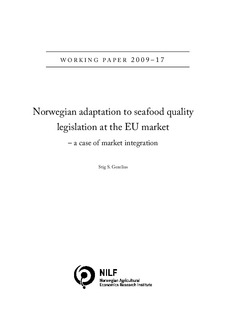| dc.contributor.author | Gezelius, Stig S. | |
| dc.coverage.spatial | European Union, Norway | nb_NO |
| dc.date.accessioned | 2018-06-12T12:15:00Z | |
| dc.date.available | 2018-06-12T12:15:00Z | |
| dc.date.issued | 2009-11 | |
| dc.identifier.isbn | 978-82-7077-757-0 | |
| dc.identifier.issn | 0805-9691 | |
| dc.identifier.uri | http://hdl.handle.net/11250/2501290 | |
| dc.description.abstract | The EU constitutes the main market for Norwegian seafood. Seafood is one of Norway’s main export products. Being a non-EU member, Norway is dependent on an efficient system for ensuring access to the EU market. When the EU developed its common market, differences in Norway’s and the EU’s legal requirements regarding food safety and animal health emerged as a significant obstacle to market access. The trade barrier represented by such different national production and quality requirements can in principle be overcome in three basic ways: mutual recognition, which means that states agree to simply accept each other’s rules; equivalence, which means that that the importing state accepts the exporting state’s regulations because these fulfil the importing state’s regulatory objectives; and harmonisation, which means that different states apply the same rules.
Norway’s strategy for facilitating access to the EU’s seafood market is a case of harmonisation through direct adoption of the importing state’s rules. Harmonisation is based on the Agreement on the European Economic Area (EEA) between EFTA, consisting of Norway and two other non EU-members, and the EU. The EEA agreement includes Norway in the EU’s common market in areas that are covered by the agreement. The EEA agreement ensures that EU rules concerning food safety and animal health are incorporated in Norwegian legislation. The EEA agreement thus entails that law-abiding Norwegian seafood exporters automatically qualify for access to the EU market. A major function of the EEA agreement is that seafood quality is verified at a national system level, hence freeing exporters from requirements for quality verification at product level. This means that exporters in EEA countries can ship their products to any other EEA country without food safety and animal health documentation as if they shipped these products within their own country. By contrast, exporters in countries outside the EEA will normally have to provide their products with such documentation in order to access the EEA/EU market. The EEA agreement thus entail that the markets of the importer and the exporter are treated as one. This market integration also means that Norway constitutes the EU’s extreme border against third countries; Norway enforces the EU’s regulations vis-á-vis third countries that export seafood to the EEA/EU market. […] | nb_NO |
| dc.language.iso | eng | nb_NO |
| dc.publisher | Norsk institutt for landbruksøkonomisk forskning | nb_NO |
| dc.relation.ispartofseries | NILF Working Paper;2009-17 | |
| dc.subject | Seafood | nb_NO |
| dc.subject | food safety | nb_NO |
| dc.subject | animal health | nb_NO |
| dc.subject | agreement | nb_NO |
| dc.subject | market access | nb_NO |
| dc.title | Norwegian adaptation to seafood quality legislation at the EU market – a case of market integration | nb_NO |
| dc.type | Research report | nb_NO |
| dc.subject.nsi | VDP::Landbruks- og Fiskerifag: 900::Fiskerifag: 920 | nb_NO |
| dc.subject.nsi | VDP::Samfunnsvitenskap: 200::Økonomi: 210 | nb_NO |
| dc.source.pagenumber | 24 | nb_NO |
| dc.source.issue | 17 | nb_NO |
| dc.relation.project | Norsk institutt for landbruksøkonomisk forskning: L077 | nb_NO |
